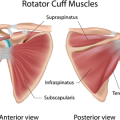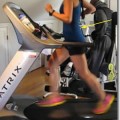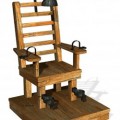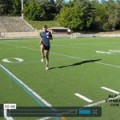In previous articles on running form, I discussed a common issue runners encounter—namely, lateral hip drop due to weak or inactive hip abductors (article 1 | article 2). In this article, I focus on the basic body position for effective running.
A common piece of advice given to runners is to “run tall.” To grasp what this looks like, imagine a straight line draw from your ankles through your ears. While running, you want to maintain a “tall” body position so that at full leg extension, a line runs more or less from the ankles up through the knees, hips, shoulders, and ears.
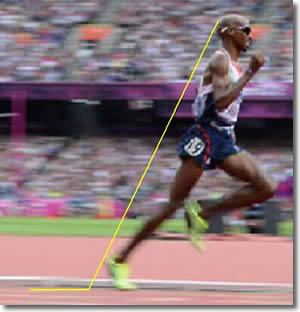
While running tall, a slight lean comes from the ankles. In other words, the ankles act as the pivot point (not the hips). Take a look at the image to the right of Olympic 10,000-meter champion Mo Farrah. Note how at toe-off the right leg is fully extended with hips and shoulders in line with the angle created by the lean from the right ankle. This subtle lean allows the runner to take advantage of gravity to maintain forward momentum.
You can get a feel for running tall with a slight forward lean by working with a running partner. Here’s how. Stand so you and your partner face each other. Partner A places their arms into the running position. Partner B holds their hands about an inch in front of Partner A’s upper chest (below the shoulders), ready to take the weight of Partner A. Partner A then drops their torso forward—leaning from the ankles—and falls into Partner B’s hands.
Again, the lean is slight and the ankles are the pivot point (do not hunch forward at the waist!). Hold this for several seconds to get a feel for this position. Make sure you are not allowing yourself to bend forward at the waist; let your partner hold your weight.
Once you and your partner have traded roles a few times, add the next component of the progression. With Partner A leaning into Partner B, Partner B steps to the side as Partner A carries momentum from the lean into a run for about 10 meters. Be sure to start with a short step to ensure the tall body position with the slight lean is maintained. The key is to carry this body position into the run.
The final component of the progression is the partner high knee drill. Start again with Partner A leaning into Partner B. Now, Partner A drives forward with high knees as Partner B provides resistance while walking/jogging backward. Here, Partner A should look something like Mo Farrah in the image above. After about 10 meters, Partner B steps to the side, and Partner A carries the form into a run for another 20 meters. The key here is for Partner A to maintain the body position and momentum from the forward lean into the run.
Another variation on the partner high knee drill is to use a running harness. You can either have a partner provide resistance by holding the harness from behind or attach the harness to a tire (no partner required) that you drag behind you.
Remember that good form in your run training holds substantial benefits, including greater resistance to injury and better running economy. Investing some extra time dedicated to drills such as those described above will eventually pay off with the dividend of “free speed.”

